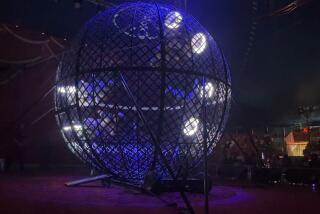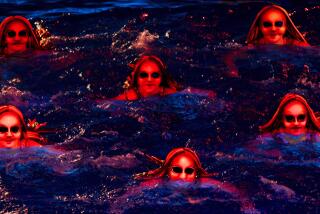Review: ‘American Experience’ runs away with ‘The Circus’
The best circus I ever saw, the Sailor Circus, took place under a tent in the parking lot or maybe the athletic field of Sarasota High School. It was performed exclusively by kids -- little kids, bigger kids, teenagers – but was a full-on big top experience, with sawdust and a calliope, acrobats and aerialists. It was pure and thrilling and beautiful. Sarasota, Fla., where I went to college for a while, was where the last two of the five Ringling brothers famously built their homes and for many years parked their circus. My college, in fact, was located half on the grounds of Charles Ringling’s estate, its library located in what had been his pink marble mansion. Brother John’s more fanciful place, right next door, was a tourist attraction.
You get a glimpse of both those houses in “The Circus,” a two-part, four-hour presentation of the invaluable historical documentary series “American Experience” airing Monday and Tuesday on PBS. Directed by Sharon Grimberg in a Ken Burns mode, it marshals archival images, enthusiastic historians and former performers to tell the story of an itinerant institution -- famous, infamous, less than entirely respectable and yet open to ladies, gentlemen and children of all ages, a bohemian enterprise that for more than a century represented the quintessence of an innocent good time. Its measured, almost elegiac Burnsean tone is somewhat inimical to its colorful, noisy subject, though Grimberg adds color where she can, animating old circus posters to giddy effect.
Circuses are ancient and everywhere, but Grimberg is concerned exclusively with the domestic variety – the traveling tent shows of the 19th and 20th centuries — and specifically with the men who ran them: your Barnum, your Bailey, your Ringling brothers (see above), as well as a few important others (Coup, Cooper, Forepaugh) whose names would be better known if the splits and mergers and acquisitions had fallen out differently. They came out of nowhere, out of humble or difficult circumstances — James Bailey faked his own death as a child to escape his abusive sister — to grow prosperous in a new form of an old sort of entertainment.
And being a story of American enterprise, it is a tale of capital and competition, of fraudulent claims and honest advertising, of big dreams, of operations growing larger, shows becoming more spectacular, stunts growing more dangerous, one outfit leapfrogging over another until it all comes crashing down. From horse-drawn wagons to purpose-built train cars; from family operations to vast armies deploying specialized technical know-how, the circus reflected the progress and fortunes of the country. It was flush in boom times, and suffered when the nation did.
Broadly speaking, the first hour is dedicated to P.T. Barnum and James Bailey, who eventually joined their outfits as Barnum & Bailey, while the second tracks the Ringling brothers – five, count them, five – who in turn acquired Barnum & Bailey, creating the Ringling Bros. and Barnum & Bailey Circus.
There are brief profiles of famous performers worked into the chronological recounting – it seems at times that we will have a report on every touring season – and more general, somewhat philosophical digressions into different aspects of circus performance and life. I wish there had been more of it; even if you’ve seen a circus you won’t necessarily know what it’s like to live in one.
“The Circus” is at times difficult to watch, because the circus, though in most respects a wonderful enterprise, has also been an awful one, particularly in its use or misuse of wild animals – many of which, more than once in this history, will perish in fires -- but sometimes in its treatment of people as well. (People, too, will perish in fires.)
Barnum’s career in what you could call show business began in 1835 with Joice Heth, a blind, mostly paralyzed slave he “leased” from her owners and exhibited as the 161-year-old nurse of George Washington; later, in his circus days, he would import and exhibit “savage” people from Africa, Australia and Asia, along with Native Americans, as “ethnographic curiosities,” alongside the traveling menageries and famous human “freaks.” Workers were not always well paid, and injury could mean abandonment. Eventually there would be strikes.
Changing times did the circus in. John Ringling North, to whom care of the family business fell, tried to update its appeal – at one point he commissioned a ballet for elephants, designed by Norman Bel Geddes and choreographed by George Balanchine to a score by Igor Stravinsky. But movies and radio and finally television took turns driving nails in the circus’s coffin, and after a difficult year that included a Teamsters strike, after a final Pittsburgh performance, North packed up the big top for good in 1956. That’s where Grimberg ends her film, though the Ringling Bros. and Barnum & Bailey Circus would go on for another 60 years under different management. When it closed for good in 2017, every major strain of American circus died at once.
So “The Circus” is kind of a memorial, but mostly a celebration — and how could it not be? The ringmaster, the clowns, lion tamers, human cannonballs, the daring young men and women on the high trapeze – they enrich our mythology and our metaphors, from “three-ring circus” on down. I can’t speak for kids these days, but you couldn’t have lived in 20th century America and not acquired a working knowledge of these characters, whether or not you’d ever been to the circus. It’s good to know them.
‘American Experience’
Where: KOCE
When: 9 p.m. Monday and Tuesday
Rated: TV-PG-L (may be unsuitable for young children with an advisory for coarse language)
Follow Robert Lloyd on Twitter @LATimesTVLloyd
More to Read
The complete guide to home viewing
Get Screen Gab for everything about the TV shows and streaming movies everyone’s talking about.
You may occasionally receive promotional content from the Los Angeles Times.







